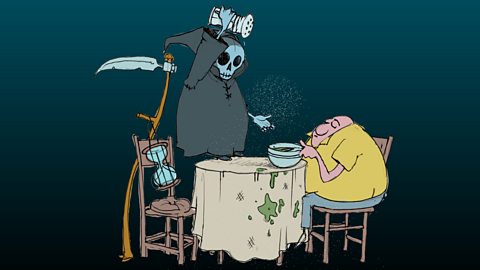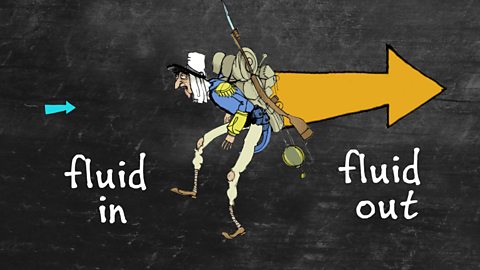Greg James: GCSE Food Preparation and NutritionEnergy NeedsIn this film you will learn about:Energywhere it comes from,how much energy we should get from each of the nutrients in ourand Energy BalanceEnergy is needed for the body to work properly and for everyday actWithout energy you couldn't do anything at all.You couldn't play sports.You couldn't even walk the dog.Even when you are fast asleep in bed, you are using energy.In fact, the amount of energy you use when you are doing nothing atis determined by something called your Basal Metabolic Rate orWithout any energy at all, you wouldn't be able to breatheand your heart would stop beating and that can only lead to oneand it's quite severe…Death!Energy is needed for life and all the everyday activities in itThe Energy we need comes from our food,specifically from the Macro-nutrientscarbohydrates, protein and fats.And we shouldn't get all our energy from just one source,but instead it's recommended that we eat a variety of macro-nutThe recommended percentages of energy that we get from them are:15% from Protein35% or less from Fatand 50% from CarbohydratesOf that 50%, 39% should come from starches that we find in foodlike potatoes, bread and pasta and a maximum of only 11% from suFactors that affect a person’s energy requirements include:their agetheir gender – generally boys and men need more energy than women aand their activity levelsthose who are less active need less energyathletes (like me) need much more.Everyone should exercise every day.Children and young people should exercise 60 minutes every dayAdults should exercise at least 30 minutes 5 times a weekBeing overweight affects our ability to exercise.Energy intake, meaning how much energy we get from our food,should match energy output, which is the amount of energywe use up through daily activity.This is known as Energy Balance.If our intake of calories from food and drinksexceeds our energy output, we gain weight.If our energy output exceeds intake, we lose weight.Balancing energy input with energy output maintainsa constant body weightSo now you should know about:Energywhere it comes fromhow much energy we should get from each of the nutrients in ourand Energy Balance
Video summary
A fact-packed but light-hearted animation, featuring the vocals talents of Radio 1's Greg James, the takes a look at the energy the body needs to function, energy balance and recommended exercise.
Without energy it would be impossible to carry out any basic daily activities.
Energy is needed for breathing and even sleeping, as well as sport and other activities.
Macro-nutrients, such as protein, fats and carbohydrates are sources of energy.
The recommended amounts of energy that should come from protein is 15%, while it’s 35% or less from fats and 50% from carbohydrates.
Of the 50% from carbohydrates, 39% should come from bread and pasta and a maximum of 11% from sugar.
A person’s energy requirements depend on their age, gender and activity levels. Men and boys generally need more energy from foods than women and girls.
Athletes need more energy than someone who is sedentary. Exercise is essential for everyone.
Adults are recommended to take at least 30 minutes exercise 5 times a week and children and young people 1 hour every day.
When energy intake matches energy output it is known as energy balance. If a person’s energy intake exceeds their output, they gain body weight.
A person loses weight if their energy intake is less than their output. Balancing energy intake with output maintains a constant body weight - energy balance.
The Royal TV Society award winning, BAFTA nominated team behind this series includes internationally renowned author and illustrator Chris Mould and one of the UK's foremost food and nutrition experts, Anita Cormac OBE.
This clip is from the series Food Preparation and Nutrition.
Teacher Notes
Most people like sugary, roasted or fried snacks but they can impact negatively on our energy balance.
Students could research typical values per 100g of Energy (KJ and Kcal) in popular branded snacks.
Which have the highest energy values? Students could devise and prepare a healthier snack that is low in sugar, fat and salt and evaluate the product for palatability and appeal as an alternative to higher calorie purchased products.
This clip will be relevant for teaching Food Technology and Modern Studies at GCSE in England, Wales and Northern Ireland.
This topic appears in OCR, Edexcel, AQA, WJEC KS4/GCSE in England and Wales, CCEA GCSE in Northern Ireland.
Eight tips for healthy eating. video
Discover he eight guidelines for a healthy diet include the foods we should eat more of and some to cut down on.

The causes of food poisoning. video
This animation outlines the causes of food poisoning, conditions for bacteria to multiply, and how to make food safe.

Food production. video
An introduction to primary and secondary food processing, using the example of wheat milled into flour and made into bread

Food Groups and the Eatwell Guide. video
A look at how the Eatwell Guide classifies food into groups and is a guide to achieving a balanced diet.

Healthy cooking methods. video
This animation investigates healthier cooking methods which limit the amount of oil or fat used.

What information is included on food packaging? video
This animation gives an insight into the labelling that must by law be included on food packaging, and what information it gives us.

How our senses guide food choices. video
How our 5 senses guide food choices, help us identify and appreciate the smell, taste and texture of food and develop our personal preferences.

The importance of staying hydrated. video
A guide to why hydration is vital for health and how water is lost from the body.

Ěý